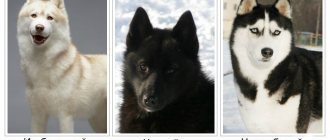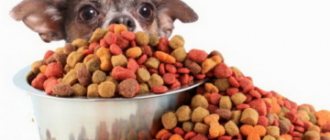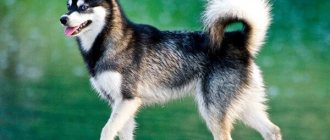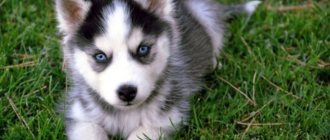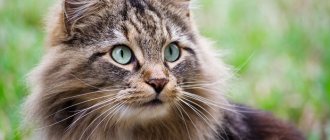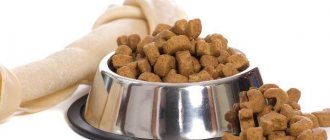Huskies are active, hardy dogs with an attractive appearance and complex character.
Despite the fact that, in general, representatives of this breed are unpretentious and do not require specific care and education, the issue of feeding them must be approached as responsibly as possible.
Because the appearance, health of the pet, and its life expectancy depend on it.
Natural food or artificial food?
The Husky diet can be based on both natural products and industrial food . It is impossible to say unequivocally which type of nutrition is better - each has advantages and disadvantages, supporters and opponents.
The only thing we can say with confidence is that nutrition must be balanced and take into account the age, health and physiological characteristics of the dog.
It is strictly forbidden to mix both types of food, since the animal’s body produces different enzymes to process natural products and feed..
A mixed diet has a negative impact on the dog's health and can lead to gastrointestinal problems.
Breeders who choose natural food for their pets motivate this mainly by the fact that all the nutrients entering the dog’s body with such a diet are of natural origin and are better absorbed.
At the same time, dry food contains all the necessary vitamins and minerals necessary for the healthy growth and proper development of a husky.
Huskies do not have a tendency to overeat and become obese and, unlike other breeds, these dogs have a protein-fat, rather than a protein-carbohydrate metabolism..
Expert opinion
Tolkachev Andrey Mikhailovich
veterinarian
The main mistake of inexperienced dog breeders is mixed nutrition. This is what most often leads to the development of various pathologies associated with the gastrointestinal tract of dogs. Also, many people mistakenly believe that natural food allows you to feed the dog leftovers from the common table, which is fundamentally wrong. That is why most breeders prefer to use industrial food that contains everything necessary for the pet’s health and has a balanced composition. Such food is easy to store and use, and the recommended daily serving size is already indicated on the packaging. The owner’s only task is to choose food that takes into account the characteristics and needs of a particular dog.
What vitamins to give huskies
For the proper development of the Husky's body, a complex of nutrients is required.
Husky is a working dog that needs regular physical activity and outdoor activities. It cannot be raised as a decorative dog, otherwise the pet's health will suffer. Husky is one of the representatives of sled dogs, although today it is used as a walking companion.
Despite the fact that huskies naturally have good health and an immune system, this breed will require proper nutrition, healthy supplements and microelements to maintain their body. First of all, huskies need those substances that ensure the health of the skeleton, ligaments, and muscular system. You should also take care of the animal’s skin and fur, as they are one of the indicators of health. Medicines are also needed to maintain the pet’s vitality and activity.
Puppies especially need vitamin A. It supports the functioning of many organs, as well as the lacrimal glands, due to which the animal’s vision is sharpened. It promotes the formation of a strong immune system in the puppy. In addition, it is a powerful antioxidant.
The diet should be varied and contain vitamins
B vitamins are necessary for a strong nervous system; they prevent the development of anemia and some other diseases. They have a positive effect on hair growth, skin health, and are necessary for the functioning of muscles, mucous membranes of the eyes and the dog’s mouth. They also contribute to the rapid growth of the animal.
Recommended reading: What vitamin is missing if your skin peels off?
Vitamins D and E influence the growth of the animal and the formation of its skeleton. Prevents the development of rickets and bone atrophy. They are important for the health of the animal’s skin and have a positive effect on the reproductive function of the pet.
Vitamins C and K are a source of protection against viruses and infections, are important for the functioning of enzymes, and are responsible for blood clotting. They also participate in metabolism and promote calcium absorption.
In addition, Husky dogs require trace elements - calcium, zinc, iodine, iron, phosphorus, sodium and many others. If the animal’s diet consists of natural products, then complexes with mineral supplements are vital.
Husky dogs often have some bad habits, by observing which the owner can understand what beneficial substances the animal’s body requires.
For example, a pet clearly does not have enough calcium if it chews on the ground or plaster. If the animal has a decreased appetite or gets tired quickly, it will require vitamin C. A lack of vitamin P leads to the fact that the husky picks up cigarette butts and eats them. In the presence of pathologies such as diarrhea, dermatitis, inflammation of the oral mucosa, vitamin PP is needed. A lack of B vitamins leads to the development of anemia. Tousled hair that lacks shine indicates a lack of vitamin A in the pet’s body. Bone pathologies indicate a lack of vitamin D.
Attention! A veterinarian will help you determine exactly what nutrients your pet is missing after examining the animal.
General recommendations for healthy feeding at home
Proper nutrition is one of the main components of healthy growth and development of a dog.
To eliminate possible mistakes regarding feeding your pet, you must follow several recommendations:
- the diet should consist of 70% dietary meat;
- you need to give your dog both boiled and raw vegetables;
- approximately 10% of the diet consists of cereals such as rice and buckwheat;
- Adult dogs should not be given milk, but fermented milk products are necessary to ensure proper functioning of the gastrointestinal tract;
- Do not feed your husky food too cold or hot;
- It is prohibited to mix industrial feed and natural products;
- all food must be fresh, prepared from high quality products;
- it is important to follow the feeding regime;
- with a natural diet, it is necessary to give your pet additional vitamins and minerals;
- The dog should always have drinking water freely available.
You should not feed your dog before bedtime, walks or trips in public transport or a car . The bowl of food should be left for 20-30 minutes, after which it should be removed, even if the dog has not eaten everything.
It is necessary to ensure that the pet receives vitamins A, E, C, D, B, K, PP, calcium, copper, iron, iodine, zinc, as well as glucosamine, collagen, chondroitin and polyunsaturated acids.
Pros and cons of natural food
A natural diet allows the owner to independently choose food for the dog, controlling their quality and freshness.
In addition, this type of nutrition has a number of other advantages.:
- the composition does not contain chemical dyes, flavors, flavor enhancers and preservatives, which not only do not provide any benefit to the dog, but can also adversely affect its health;
- all vitamins and macro- and microelements contained in the products are of natural origin and are better absorbed by the animal’s body;
- If your pet has an allergic reaction to one of the products, it can be replaced with an analogue without changing the entire diet.
In addition, with a natural diet, you can make the husky’s menu as varied as possible, which will minimize or completely eliminate the likelihood that the dog will get bored with food.
The disadvantages of this type of nutrition include:
- large amounts of time spent preparing food for your pet;
- inconveniences associated with feeding while traveling;
- lack of opportunity to prepare food for future use.
It is also important to understand that it is impossible to independently create a balanced diet for a husky without certain knowledge of veterinary nutrition..
List of permitted and prohibited products
When choosing natural food in the husky menu, you must include:
- meat (beef, veal, poultry, rabbit) is a source of protein, iron, magnesium, calcium, vitamins A, E, D;
- offal (trachea, tripe, liver, lungs, ears, lips, tendons, tails) - to preserve the maximum amount of useful substances, you need to purchase and cook them in an unrefined form;
- sea fish without bones, scales, gills, intestines (salmon, salmon, pink salmon) - contains protein, zinc, magnesium, calcium, iodine;
- boiled eggs are a source of protein, animal fat, organic acids, vitamins and microelements;
- eggshells - a small amount as an additional source of calcium;
- fermented milk products (natural yogurt, kefir, cottage cheese) are a source of calcium and contribute to the normal functioning of the gastrointestinal tract;
- animal and vegetable fats (fish, olive, soybean, sunflower, corn oil);
- vegetables and fruits (carrots, tomatoes, pumpkin, cabbage, zucchini, turnips) are a source of vitamins C, B, A, fiber, microelements and acids;
- cereals (rice, buckwheat, oatmeal);
- large "sugar" bones.
You can't feed the husky:
- confectionery products;
- grapes and raisins;
- pork and lamb;
- pickles, smoked meats;
- oranges, tangerines;
- potatoes;
- milk;
- spicy, salty foods;
- tubular bones;
- river fish;
- bread and baked goods;
- pasta;
- legumes;
- chicken feet and bones;
- lard;
- nuts.
It is also prohibited to give your dog vitamins intended for humans and leftovers from the common table.
Sample menu for the week
| Day of the week | Daily menu | Menu under workload |
| Monday | 400 g chicken meat, sprinkled with yogurt, 150 g buckwheat porridge, 1 tsp. vegetable oil, 150 g boiled carrots and beets | 300 g chicken meat, 200 ml yogurt, 2 boiled carrots, 150 g internal organs, offal and trimmings, 150 g buckwheat porridge, 130 ml kefir |
| Tuesday | 450 g veal kidneys and offal, 200 ml kefir, 130 g green vegetables | 250 g sea fish, 150 g rice porridge, 1 raw egg, 250 g offal, 150 g yogurt, 120 g boiled vegetables |
| Wednesday | 500 g pink salmon, 150 g rice porridge, 200 ml natural yogurt | 300 g beef, 120 g yogurt, 1 tsp. vegetable oil, 120 g boiled cabbage and beets, 200 g buckwheat porridge, 150 g cottage cheese, 1 apple |
| Thursday | 450 g rabbit or beef, 150 g yogurt, 130 g boiled carrots and celery, 1 raw egg | 250 g chicken waste, 150 g oatmeal, 20 g boiled carrots, 1 tsp. vegetable oil, 250 g rabbit meat, 200 ml yogurt, 120 g boiled pumpkin, 1 raw egg |
| Friday | 450 g internal organs, offal, poultry trimmings, 150 g oatmeal, 150 g cottage cheese, 1 tsp. vegetable oil | 300 g chicken fillet, 280 ml yogurt, 130 g boiled beets and celery, 1 tsp. vegetable oil, 200 g oatmeal, 150 g cottage cheese, 1 apple |
| Saturday | 450 g veal, 200 g natural yoghurt, 130 g boiled pumpkin, 1 raw egg | 250 g sea fish, 150 g rice porridge, 1 raw egg, 200 g beef offal and trimmings, 150 ml yogurt, boiled carrots |
| Sunday | 250 g buckwheat porridge with meat, 200 g cottage cheese, 150 ml natural yogurt, 1 apple | 300 g veal, 150 g buckwheat porridge, 280 ml yogurt, 1 tsp. vegetable oil, 200 g offal, 130 g boiled vegetables, 1 egg |
Sample menu for the day
Depending on the age of the dog, the number of meals is as follows:
- up to 2 months – 4 times a day;
- up to 6-12 months – 3 times;
- after 12 - 2 times, 1 feeding is allowed.
Sample menu:
- Breakfast should include cottage cheese or low-fat yogurt; grated carrots, banana.
- For lunch you should have meat or fish.
- For dinner, porridge with vegetables and meat.
According to veterinarians, poor appetite in huskies is quite normal. Adults may refuse to feed for 2 days; such behavior should not cause panic.
Industrial feed
As with natural nutrition, feeding with industrial feed has both advantages and disadvantages.
The advantages of such a diet include:
- balanced composition, enriched with all necessary vitamins, macro- and microelements, which eliminates the need to take additional nutritional supplements;
- saving time on preparing food for your dog;
- simplicity and ease of use and storage;
- the opportunity to buy food for the husky for future use;
- indication on the packaging of information regarding the daily intake of feed.
A wide range of industrial feeds allows you to choose a diet for your pet in accordance with its age, activity level, physiological characteristics and health status.
In addition, a special composition covering dry food granules acts as an additional measure to prevent the formation of plaque and stones.
Disadvantages of this diet:
- Cheap feeds may contain low-quality meat and offal;
- there is a possibility of the presence of artificial colors, flavors, preservatives and flavor enhancers.
It is also important to understand that if an allergic reaction occurs to one of the components of the food, the dog’s diet will need to be completely changed.
NOTE!
Industrial feeds can be not only dry, but also wet - they contain up to 80% liquid.
Products of different quality can be used in feed, which is why they are divided into several classes.:
- economy - the composition is based on low-quality products, the possibility of containing soy, beans, and chemical additives is possible;
- premium - products of this class are based on meat, offal and vegetables, but the composition is not enriched with vitamins and minerals;
- super premium - high quality products are used to make such food; vitamins and minerals are included.
Also, almost every company produces lines of hypoallergenic and holistic food, the composition of which is close to natural nutrition.
How to feed a puppy correctly?
The table shows how to properly feed a puppy by month.
| Age | What to feed | Number of feedings per day |
| 1 month | Newborn puppies feed on mother's milk; if this is not possible for any reason, milk substitutes (Royal Canin Babydog Milk) should be used. You should start feeding puppies at 3-4 weeks, gradually giving them milk porridge, cottage cheese, meat broth, grated boiled carrots | 6-8 |
| 2 months | You can gradually introduce new vegetables, herbs, cereal porridge with finely chopped meat, eggs, fruits (grated apples), and dairy products into your diet. | 5 |
| 3-4 months | At the age of 3 months, huskies eat raw meat, otherwise the diet remains unchanged. By 4 months, instead of meat, you can occasionally give sea fish | 4 |
What to feed a husky puppy
If feeding a husky puppy with bitch milk for up to a month is ideal, then it is necessary to gradually transfer the animal to natural food or ready-made dry food, the granules of which are soaked in meat broth or ordinary clean water.
Diet in the first month
For the first month, the puppies should be fed by the bitch, but if for some reason it is necessary to transfer the pet to artificial feeding, then it is best to use the bitch milk substitute “Royal Canin Babydog Milk” for this purpose.
This is interesting! For stable and complete growth and development of a husky puppy, the composition of such a mixture is as close as possible to the natural composition of the bitch’s milk, and is characterized by a sufficient content of proteins and energy.
The mixture is very easy to dilute without the formation of lumps. The packages, in addition to the mixture itself, contain a convenient graduated bottle with a wide neck, which makes it easy to wash and sterilize, three nipples of different sizes and with different holes, as well as a measuring spoon for the most accurate dosing.
Diet from one month to six months
From one month to six months, the optimal ready-made food for huskies is “Harry Dog Medium Baby 28”. It is distinguished by the content of exclusively high-quality raw materials, represented by poultry, lamb, sea fish, rice, and New Zealand shellfish. This composition is also well suited for feeding puppies sensitive to food .
Starting from six months, after changing teeth, the pet is switched to ready-made food with a reduced protein content. Puppies are given dry food soaked in warm water. The daily intake for up to two months should be divided into three or four feedings, and then into two or three feedings.
Diet from six months to a year
Starting from six months, you can switch your pet to Narry Dog Medium Junior 25, which contains 25% protein, which helps prevent excess protein in the dog’s body. The daily intake should be divided into two feedings. When feeding naturally, you should give preference to the following products:
- meat products, mainly lightly boiled beef, turkey or chicken, sea fish;
- raw quail egg yolk or omelette;
- boiled vegetables in the form of carrots, beets and cabbage;
- dairy products in the form of cottage cheese, kefir and cheese.
Be sure to give crumbly rice or buckwheat porridge, cooked in meat or fish broth, or with the addition of a small amount of vegetable oil.
How to feed an adult dog
When the dog reaches the age of 1 year, it needs to be switched to two feedings a day.
When a diet based on industrial food, you should follow the recommendations indicated by the manufacturer on the packaging, and choose the food itself taking into account all the characteristics of the pet.
IMPORTANT!
Natural feeding should be based on animal protein - the husky’s diet should contain at least 70% meat and meat products.
In general, representatives of this breed eat quite little, which is due to their occurrence. The ancestors of modern huskies spent a lot of time on the road and survived in conditions of nutritional deficiency.
It was these factors that determined the formation of a special metabolism in these dogs..
Whatever the type of nutrition, it is important to follow the feeding regimen and basic recommendations for choosing and preparing a diet.
What to feed an adult husky
An adult Husky dog can be fed natural food or ready-made diets with a balanced composition . The second option, according to dog breeders and veterinarians, is the most preferable.
Diet from year
Starting from the age of one year, your pet must be gradually and smoothly transferred to age-appropriate food. The Narry Dog Fit&Well line is very suitable for feeding an adult dog. If your pet has a food allergy, it is advisable to use the hypoallergenic Sensible Nutrition food.
To prevent the manifestation of nutritional deficiency, for animals prone to disruptions in the gastrointestinal tract, a complex of feeds “Harry Dog + Consert” has been developed. Connoisseurs of natural nutrition can use “HAPPY DOG” flakes, which are recommended to be mixed with meat or vegetable puree.
Diet for older dogs
As a pet ages, it is necessary to correctly and promptly change its diet or wisely select food for elderly, aging or inactive dogs. Older dogs are especially in dire need of vitamins B6, B12, A and E. If a pet has problems with the musculoskeletal system or joints, then you should pay attention to vitamin and mineral complexes with a sufficient content of chondroitin and glucosamine.
